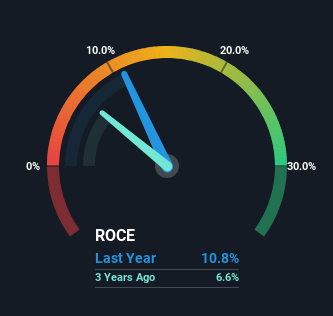Rain Industries (NSE:RAIN) Will Be Hoping To Turn Its Returns On Capital Around
What trends should we look for it we want to identify stocks that can multiply in value over the long term? Amongst other things, we'll want to see two things; firstly, a growing return on capital employed (ROCE) and secondly, an expansion in the company's amount of capital employed. Basically this means that a company has profitable initiatives that it can continue to reinvest in, which is a trait of a compounding machine. In light of that, when we looked at Rain Industries (NSE:RAIN) and its ROCE trend, we weren't exactly thrilled.
What Is Return On Capital Employed (ROCE)?
Just to clarify if you're unsure, ROCE is a metric for evaluating how much pre-tax income (in percentage terms) a company earns on the capital invested in its business. Analysts use this formula to calculate it for Rain Industries:
Return on Capital Employed = Earnings Before Interest and Tax (EBIT) ÷ (Total Assets - Current Liabilities)
0.11 = ₹20b ÷ (₹217b - ₹32b) (Based on the trailing twelve months to June 2023).
So, Rain Industries has an ROCE of 11%. In isolation, that's a pretty standard return but against the Chemicals industry average of 15%, it's not as good.
See our latest analysis for Rain Industries

Historical performance is a great place to start when researching a stock so above you can see the gauge for Rain Industries' ROCE against it's prior returns. If you want to delve into the historical earnings, revenue and cash flow of Rain Industries, check out these free graphs here.
What The Trend Of ROCE Can Tell Us
On the surface, the trend of ROCE at Rain Industries doesn't inspire confidence. Around five years ago the returns on capital were 17%, but since then they've fallen to 11%. Although, given both revenue and the amount of assets employed in the business have increased, it could suggest the company is investing in growth, and the extra capital has led to a short-term reduction in ROCE. If these investments prove successful, this can bode very well for long term stock performance.
In Conclusion...
In summary, despite lower returns in the short term, we're encouraged to see that Rain Industries is reinvesting for growth and has higher sales as a result. However, despite the promising trends, the stock has fallen 22% over the last five years, so there might be an opportunity here for astute investors. As a result, we'd recommend researching this stock further to uncover what other fundamentals of the business can show us.
One more thing, we've spotted 3 warning signs facing Rain Industries that you might find interesting.
While Rain Industries may not currently earn the highest returns, we've compiled a list of companies that currently earn more than 25% return on equity. Check out this free list here.
New: AI Stock Screener & Alerts
Our new AI Stock Screener scans the market every day to uncover opportunities.
• Dividend Powerhouses (3%+ Yield)
• Undervalued Small Caps with Insider Buying
• High growth Tech and AI Companies
Or build your own from over 50 metrics.
Have feedback on this article? Concerned about the content? Get in touch with us directly. Alternatively, email editorial-team (at) simplywallst.com.
This article by Simply Wall St is general in nature. We provide commentary based on historical data and analyst forecasts only using an unbiased methodology and our articles are not intended to be financial advice. It does not constitute a recommendation to buy or sell any stock, and does not take account of your objectives, or your financial situation. We aim to bring you long-term focused analysis driven by fundamental data. Note that our analysis may not factor in the latest price-sensitive company announcements or qualitative material. Simply Wall St has no position in any stocks mentioned.
About NSEI:RAIN
Rain Industries
Manufactures and sells carbon, advanced materials, and cement products in India and internationally.
Low risk and slightly overvalued.
Similar Companies
Market Insights
Community Narratives



